

The Caledonian MacBrayne fleet consists of 14 major vessels, 13 double-ended ferries and 2 bow-loading ferries. The fleet is relatively modern (the oldest vessel dates from 1975), and CalMac have more vessels sailing under the British flag than any other company. All vessels in the current fleet were built for Caledonian MacBrayne, mostly in Scotland. The vessels are actually owned by Caledonian Marine Assets Limited (CMAL) and chartered to CalMac; all vessels are registered in Glasgow.
(All photographs are © Iain Murray 2011 - click on the small pictures to see a larger picture; click on the name to view the official CalMac info on the ship)
New Polish-built ship for service on the Kennacraig-Islay route; has been experiencing some teething problems.
(Almost) identical sister ship of Bute, also for service on the Wemyss Bay-Rothesay route.
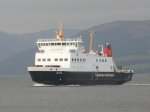 Arriving at Rothesay (4th October 2005)
Arriving at Rothesay (4th October 2005)
 Panorama of the vehicle deck (BIG image)
Panorama of the vehicle deck (BIG image)
A new vessel built in Poland for the Wemyss Bay-Rothesay service in 2005 - not much longer than the "streakers", but vastly more car and passenger deck space! She is driven by azimuthing thrusters fore and aft, giving similar manoeuvrability to the older vessels with their VSPs.
Most unusual ferry built for the summer Mallaig-Armadale and Clyde relief in winter. A whole lot of ugly in one place.
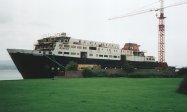 Fitting out at Ferguson's, Port Glasgow (4th September 2000)
Fitting out at Ferguson's, Port Glasgow (4th September 2000)
A recent replacement for the Hebridean Isles on the Skye-North Uist/Harris service. She is very similar in appearance to the Clansman.
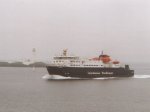
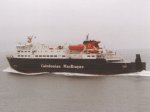 In the Sound of Mull (7th July 1999)
In the Sound of Mull (7th July 1999)
This vessel joined the CalMac fleet in 1998, for service on the Oban-Barra-South Uist service.
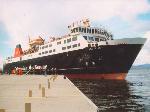 After launching at Port Glasgow (18th April 1995)
After launching at Port Glasgow (18th April 1995)
Isle of Lewis is CalMac's largest vessel, and has served the Ullapool-Stornoway service since July 1995. She is the only double-funneled CalMac vessel without an open stern.
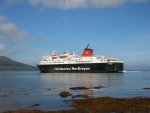 Departing Brodick, Arran (10th October 2007)
Departing Brodick, Arran (10th October 2007)
Caledonian Isles is the largest CalMac vessel on the Clyde, and operates the popular Arran service from Ardrossan to Brodick.
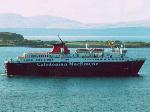 In Oban Bay (May 1989)
In Oban Bay (May 1989)
Isle of Mull was built to serve that island from Oban. A design problem required her to be lengthened by 20' at the end of her first year in service.
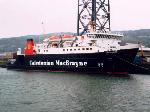 Fitting out, Greenock (April 1989)
Fitting out, Greenock (April 1989)
Lord of the Isles was built for the service from Oban to Coll, Tiree, Barra and South Uist, but now operates the seasonal Mallaig-Armadale (Skye) service. Forward, she is similar in design to Isle of Mull, but has an open stern with a hoist.
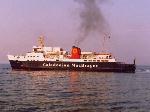 Departing Brodick, Arran (July 1991)
Departing Brodick, Arran (July 1991)
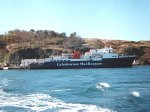
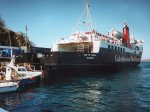 At Port Askaig, Islay (30th April 1999) - pictures by Norman Alm
At Port Askaig, Islay (30th April 1999) - pictures by Norman Alm
Isle of Arran was built to serve that island from Ardrossan, but since the arrival of the larger Caledonian Isles in 1993 has been the main vessel on the Islay service. Note the different hull paint levels in the pictures above.
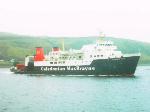 Arriving at Uig, Skye (September 1988)
Arriving at Uig, Skye (September 1988)
Hebridean Isles was built to serve the triangular route between Uig (Skye), Lochmaddy (North Uist) and Tarbert (Harris), and has been closely associated with that route since entering service (though the NorthUist-Harris leg is now operated by the Loch Bhrusda).
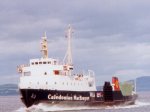 Approaching Dunoon (13th July 1998)
Approaching Dunoon (13th July 1998)
Saturn was built for the service to Bute, and originally bore the legend "ROTHESAY FERRY" on her hull sides. Since 1986, she has rotated duties frequently with the Jupiter and Juno (and more recently, Pioneer) and so appears on the Dunoon service also. She is a quasi-sister to the older Jupiter and Juno, having a slightly different forward hull shape with a strake, different bridge structure (which allows passengers a view forward) and a simpler mainmast, though these changes make her less attractive. Since the withdrawal of the vehicle service on the Gourock-Dunoon route at the end of June 2011, she has been spare, though will probably operate to Arran over the summer of 2011 prior to being withdrawn.
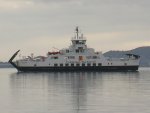 Arriving at Largs (12th October 2007)
Arriving at Largs (12th October 2007)
The most recent of the "Loch" double-ended ferries, built for the Largs-Cumbrae slip service.
A smaller wholly double-ended version of Coruisk built for the Leverburgh (Harris)-Berneray service.
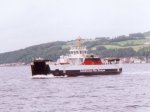 Departing Largs (16th July 1998)
Departing Largs (16th July 1998)
Similar to Loch Bhrusda (but with Voith-Schneider propulsion again), this vessel joined the fleet in summer 1997 on the Lochaline-Fishnish service; she was launched as Loch Aline but renamed to Gaelic form as English form already on the shipping register. Due to major propulsion problems after entering service, she was redeployed to the Largs-Cumbrae Slip service in 1998, being replaced at Fishnish by the Loch Fyne, and she is now the main vessel between Eriskay and Barra.
Yet another variation on the Loch-class theme - she has a similar hull form (though with Schottel propulsion rather than Voith-Schneider propulsion as in the earlier vessels) but with a central bridge over the car deck rather similar to Western Ferries' Sound of Sleat. Built for the new service from Otternish (North Uist) to Berneray and Leverburgh (Harris), she broke the "Skye Triangle" meaning that the larger ferry no longer sails direct between North Uist and Harris. Now replaced by the larger Loch Portain, this vessel is now spare.
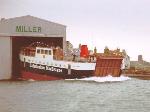 Launching at St. Monans (February 1992)
Launching at St. Monans (February 1992)
Loch Tarbert was built for the Cloanaig-Lochranza (Arran) service. Also similar to the older Loch-class vessels, she has passenger accommodation on one side only, allowing a 50% greater vehicle capacity. Consequently she has no windows down her port side, which also sports a funnel.
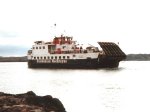 Departing Iona (6th July 1999)
Departing Iona (6th July 1999)
Loch Buie was built for the Fionnphort-Iona service. Though similar to the older Loch-class vessels, she has less car space (not needed on this service) and more passenger accommodation. The extra passenger accommodation over the car desk makes her the most easily identified of the Loch-class.
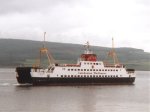 Loch
Fyne departing Fishnish, Mull (7th July 1999)
Loch
Fyne departing Fishnish, Mull (7th July 1999)
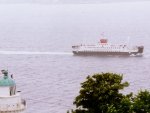 Loch
Dunvegan heading up the Clyde past the Cloch lighthouse on a dreich
Sunday (12th July 1998)
Loch
Dunvegan heading up the Clyde past the Cloch lighthouse on a dreich
Sunday (12th July 1998)
These vessels were built to replace the ageing Lochalsh and Kyleakin on the short Kyle of Lochalsh-Kyleakin (Skye) service. They were made redundant in 1995 by the opening of the controversial Skye bridge, and spent some time laid up in Greenock awaiting sale. In 1998, they were redeployed to other routes (as had been originally intended), the Loch Fyne to Fishnish-Lochaline and the Loch Dunvegan to Colintraive-Rhubodach.
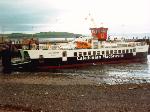 Loch Striven at Largs (September 1988)
Loch Striven at Largs (September 1988)
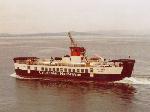 Loch
Linnhe departing Largs (May 1990)
Loch
Linnhe departing Largs (May 1990)
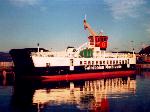 Loch
Riddon at Rothesay (1988)
Loch
Riddon at Rothesay (1988)
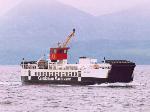 Loch
Ranza approaching Cloanaig (July 1991)
Loch
Ranza approaching Cloanaig (July 1991)
These double-ended vessels were built to operate on a variety of short crossings, originally on the Firth of Clyde. Loch Riddon and Loch Linnhe are usually on the Largs-Cumbrae Slip service, with Loch Striven now on the Raasay service. Loch Ranza was originally used on the Cloanaig-Lochranza (Arran) service, but is now usually on the Tayinloan-Gigha service.
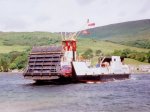 Arriving at Rhubodach, Bute (13th July 1998)
Arriving at Rhubodach, Bute (13th July 1998)
Isle of Cumbrae was built to serve that island from Largs, and did so until displaced by the new Loch-class vessels (for which she was the forerunner). In recent years on the Lochaline-Fishnish (Mull) and Colintraive-Rhubodach (Bute) services, she is now the main Portavadie-Tarbert vessel.
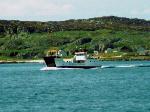 Morvern approaching Fionnphort (September 1988)
Morvern approaching Fionnphort (September 1988)
These two bow-loading vessels (and their six sisters Kilbrannan, Morvern, Rhum, Coll, Bruernish and Canna, since sold) were built to operate a variety of short crossings throughout the Clyde and Western Isles; each can carry six cars (Kilbrannan and Morvern were similar but slightly smaller). All vessels have been used interchangeably on a variety of routes, but some have become associated with particular services. Morvern was usually on the Iona service until replaced, Coll on the Kilchoan-Tobermory (Mull) service, Eigg has been closely tied to the Oban-Lismore service and Raasay has been closely tied to her namesake island (until replaced). Canna was usually on the Lochaline-Fishnish (Mull) service until replaced and moved to the Scalpay service (now replaced by a bridge), while Rhum was used mainly on the Cloanaig-Lochranza (Arran) service until replaced; then she operated the Portavadie-Tarbert service. Eigg still maintains the Oban-Lismore service, with Rasaay as spare vessel.
Go to the Caledonian MacBrayne unofficial web page or the Caledonian MacBrayne official web page
Go to Iain Murray's home page or send me an e-mail
Go to the Applied Computing home page
Go to the University of Dundee home page